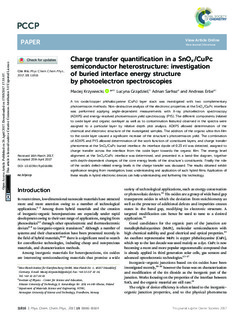| dc.contributor.author | Krzywiecki, Maciej | |
| dc.contributor.author | Grzadziel, Lucyna | |
| dc.contributor.author | Sarfraz, Adnan | |
| dc.contributor.author | Erbe, Andreas | |
| dc.date.accessioned | 2017-05-19T08:58:54Z | |
| dc.date.available | 2017-05-19T08:58:54Z | |
| dc.date.created | 2017-05-17T21:01:29Z | |
| dc.date.issued | 2017 | |
| dc.identifier.citation | Physical Chemistry, Chemical Physics - PCCP. 2017, 19 11816-11824. | nb_NO |
| dc.identifier.issn | 1463-9076 | |
| dc.identifier.uri | http://hdl.handle.net/11250/2442866 | |
| dc.description.abstract | A tin oxide/copper phthalocyanine (CuPc) layer stack was investigated with two complementary photoemission methods. Non-destructive analysis of the electronic properties at the SnOx/CuPc interface was performed applying angle-dependent measurements with X-ray photoelectron spectroscopy (ADXPS) and energy-resolved photoemission yield spectroscopy (PYS). The different components (related to oxide layer and organic overlayer as well as to contamination features) observed in the spectra were assigned to a particular layer by relative depth plot analysis. ADXPS allowed determination of the chemical and electronic structure of the investigated samples. The addition of the organic ultra-thin film to the oxide layer caused a significant increase of the structure's photoemission yield. The combination of ADXPS and PYS allowed determination of the work function of constituent layers, and charge transfer phenomena at the SnOx/CuPc buried interface. An interface dipole of 0.23 eV was detected, assigned to charge transfer across the interface from the oxide layer towards the organic film. The energy level alignment at the SnOx/CuPc interface was determined, and presented in a band-like diagram, together with depth-dependent changes of the core energy levels of the structure's constituents. Finally the role of the oxide's defect-related energy levels in the charge transfer was discussed. The results obtained exhibit significance ranging from investigation, basic understanding and application of such hybrid films. Application of these results in hybrid electronic devices can help understanding and furthering this technology. | nb_NO |
| dc.language.iso | eng | nb_NO |
| dc.publisher | Royal Society of Chemistry | nb_NO |
| dc.rights | Navngivelse 4.0 Internasjonal | * |
| dc.rights.uri | http://creativecommons.org/licenses/by/4.0/deed.no | * |
| dc.title | Charge transfer quantification in a SnOx/CuPc semiconductor heterostructure: investigation of buried interface energy structure by photoelectron spectroscopies | nb_NO |
| dc.type | Journal article | nb_NO |
| dc.type | Peer reviewed | nb_NO |
| dc.source.pagenumber | 11816-11824 | nb_NO |
| dc.source.volume | 19 | nb_NO |
| dc.source.journal | Physical Chemistry, Chemical Physics - PCCP | nb_NO |
| dc.identifier.doi | 10.1039/c7cp01688c | |
| dc.identifier.cristin | 1470693 | |
| dc.description.localcode | This article is licensed under a Creative Commons Attribution 3.0 Unported Licence. | nb_NO |
| cristin.unitcode | 194,66,35,0 | |
| cristin.unitname | Institutt for materialteknologi | |
| cristin.ispublished | true | |
| cristin.fulltext | original | |
| cristin.qualitycode | 2 | |

